My children are at the age where calling them kids becomes increasingly dubious. Sixteen and twenty-one years of age, they spend more time away from home every year. That doesn’t mean that stepping on LEGOs is a past hazard- the threat is still very real.
(And yes, I know that the correct term is LEGO, not LEGOs. Old habits die hard)
So when it came time to write a 1THING: New Build post on lighting for kids’ bedrooms, I had plenty of research material readily available. Literally next door to my office, in fact, is a room occupied by offspring that could use better lighting. If I were building the house from scratch, how would I light their room? What would I design if I could only choose one solution?
The answer, like all lighting answers, comes from closer examination of what light they need.

I admit that we generally design better lighting for primary bedrooms than for children. We even had one client ask for bad lighting in their children’s rooms. “We want them to leave,” they said. When I stop to think about how we light children’s rooms, however, it occurs to me that perhaps we have it backwards. After all, what happens in the primary bedroom?
If our bedroom is any indication, not much happens. We sleep. We get dressed. And a few other things that do not require much light at all. Our kids rooms, especially when they were younger, need to cover a lot more activities. Their lighting, in other words, needs to be pretty good and pretty adaptable to a wide variety of tasks.

Above is a handy little diagram of where adults need lighting in a bedroom…and where kids need it. I am reminded of Robin William’s genie from Aladdin saying “the exits are here, here, here,…anywhere!” as they prepared to disembark the magic carpet. Kids need lighting here, here, here…anywhere! And, as a parent, I know that light everywhere can be a good thing.
Lately we’ve been working on a LEGO castle together, a project that has spanned a decade, seen multiple renovations and additions, and is now surrounded by a detailed town and a moat. I was enlisted to help raise the entire castle on a new plinth of stone, an endeavor that took a bit of planning and more than a bit of work.
And I realized, much to my chagrin, that either LEGOs are smaller than they used to be or my eyes have gotten worse. I needed more light. I needed better light. And here’s what the bedrooms in our home have:

Yep, these are perfect examples of advanced CFLS (Ceiling Fan Light Syndrome). Not the right kind of light for our bedroom or our children’s, but that doesn’t stop it from being the most typical lighting found in a vast majority of homes. The ceiling fan light is great for packing a suitcase and pretty much horrible for everything else, a good source of glare and shadow that makes rooms ugly, uncomfortable, and of dubious function.
What kids need in their bedrooms mirrors the way my own seem to store their things: spread out everywhere.

The sketch above shows a decorative fixture called a semi-flush mount. If your home is older, think of the classic schoolhouse globes, those white-glass fixtures that hung in rows in the schools of yesteryear (before buzzing fluorescents took over). I would put four of them in the room, in a basic grid (the kind I eschew elsewhere, but kids rooms are different). Light would be everywhere – and four of them chases away shadows and lowers the need for super-bright bulbs. The result is a brighter-but-softer illumination that works for most activities in kids rooms.
Am I breaking my own rules? Maybe, but keep in mind that four semi-flush fixtures with soft globes will provide an entirely different kind of light than a disc light or downlight. Also keep in mind that the activities in an adult bedroom change very little over twenty years. The activities in a 5-year-old’s room may be entirely different than a 12-year-old’s room…which in turn may be different than a 17-year-old’s room. In other words, lighting in the kids rooms needs to be better, needs to be everywhere.
If we get it right, we might protect our feet from LEGO pain. Or we could buy good slippers….
View my post on new build primary bedrooms.
View my post on plug-in primary bedrooms.
